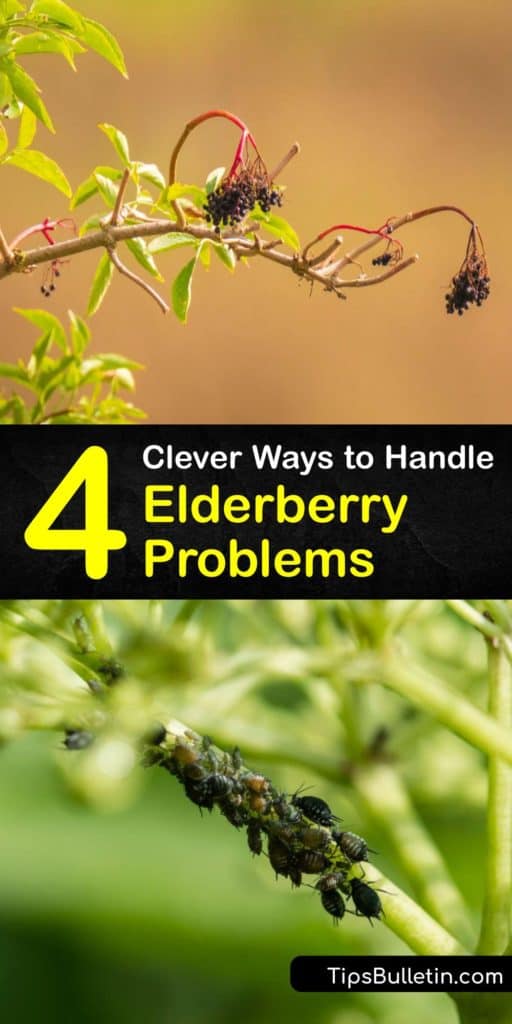Elderberry is a medicinal plant that humans are turning to for treating many health issues. Between elderberry syrup, gummies, lozenges, and working as a diuretic, growing your own at home is a simple way to always have some on hand. Unfortunately, there are a few elderberry problems that you may come across during your gardening journey.
Elderberry bugs are only half of the difficulty. It becomes more complicated when we spot elderberry leaves turning yellow. Without healthy plants, we can’t harvest the berries and use them to support our immune system.
The two most popular types are Sambucus nigra and Sambucus canadensis, and there are a few different elderberry plant cultivars. Most home gardeners grow elderberry like the Black Lace or American Black elderberry.

Common Elderberry Issues
Elderberry plants grow fruits that look similar to blackberries and contain flavonoids called anthocyanins and glycosides that support our immune systems and give us certain health benefits.
If these aren’t reasons enough to avoid elderberry disease in your garden, then the flavor of the berries alone might convince you.
A lot can go awry during the growing process, whether it’s an elderberry disease or a common pest. Of course, if you have these deciduous plants in your garden, you’re either growing them for their sweet fruits or nutritional benefits.
Elderberries are rich in vitamin C, B, and E. Elderberry extract is often taken as nutritional supplementation and used to treat constipation, headaches, fever, joint pain, epilepsy, skin conditions, stress, and muscle pain.

If you live in USDA hardiness zones three through seven, you’re already on the right path to growing large, healthy plants. Still, you’ll likely have a few elderberry problems regardless of which hardiness zone you reside in, just like when growing blackberries or mulberries.
The Most Common Elderberry Problems
If you notice the elderberry leaves turning a strange color or wilting, then you’re probably not giving your plants all of the basic requirements they need to thrive, whether you are growing elderberries in containers or your yard. Learn the best time to transplant an elderberry tree for the best chance of success in your yard.
The same applies to raspberry problems. Elderberry bushes should have green leaves and bunches of small white flowers.
Start by planting your elderberry plants in the early spring and choose an elderberry location where they receive full sun. Place two different plant cultivars at least 50 feet away from each other for them to cross-pollinate.
The garden bed soil should have a pH range between 5.5 and 6.5. They enjoy sandy or loamy soil that is well-draining. Prune the branches whenever they look a little out of control.
Elderberry plants also benefit from occasional fertilization from compost and a good watering whenever the soil dries out. Choose an elderberry bush fertilizer for fruiting plants for the best results. They are among the bushes and trees that like wet soil over dry dirt.
The better you care for them, the sooner you can harvest the berries for their antioxidant properties.
Remove the stems from the fresh berries and place the fruits in the top part of a steam juicer. Steam the berries for 30 minutes or until the juice starts running freely. Press the berries lightly to remove as much of the juice as possible.
Pour the hot liquid into a pan and add the ginger. Simmer the juice and ginger over a low temperature for 30 minutes until it reduces by half. Pour the elderberry juice through a mesh strainer.
Stir the honey into the strained berry juice and stir well. Pour your syrup into a sanitized glass bottle and put on the lid. Keep the syrup refrigerated for several weeks or store it in the freezer. For more extended storage, seal the canning jar in a boiling water bath for 10 minutes.
Elderberry Bugs
It’s nearly impossible to avoid every type of garden pest. Don’t panic if you notice a couple of elderberry bugs hanging out on your plants. These are typically easy to remove with pesticides or avoid altogether with floating row covers.
Some of the most common pests that you find on elderberry plants are cane borers, aphids, and thrips. These are all winged insects that feast on the leaves of your plants.
Some are more challenging to spot than others, so make sure you check the underside of the leaves. Remove the garden bugs by hand or with a steady stream of water and put some kind of deterrent in place to keep them from coming back.
Elderberry Leaves Turning Yellow
Yellowing plants are a good indication that something is wrong with your crops. It’s hard to know exactly what is occurring. Fungal cankers, verticillium wilt, leaf spot, and root rot are all likely problems.
Start narrowing down the options by checking that you aren’t overwatering your plants and attracting fungus and bacteria.
If the issue continues, consider pruning the affected leaves or spraying them with fungicide. However, if dealing with verticillium wilt, your safest option is to destroy the infected plants so they don’t transfer to the other crops in the garden.
Overwatering Issues
Too much water attracts unwanted elderberry problems like powdery mildew. Mildew thrives in warm, wet locations, and you could either water your plants too much or not allow enough air circulation.
Remember that the plants’ environment is often a significant factor in whichever issues are taking place. If your leaves get covered in a powdery white substance, remove all of the affected leaves before they overwinter and stunt the entire plant.
Learn the proper way to prune elderberry bushes just like you practice the best way to prune raspberry vines for airflow and disease prevention.
Elderberry plants are an excellent crop to grow at home. They are not only delicious, but they benefit us in many different ways and help our immune systems thrive. Look forward to harvesting elderberries at the end of the season for use in all kinds of recipes.
Gardening with any type of plant comes with its own specific set of hurdles, but if you know what to look for, you have a much better chance of getting ahead of the problem and saving the plants around your yard.
You don’t have to let these pests and diseases destroy your hard work in such a short period if you educate yourself and prepare for them in advance.

If learning about these common elderberry problems has helped you grow large, healthy bushes, share this article with tips to stop elderberry leaves turning yellow on Facebook and Pinterest.